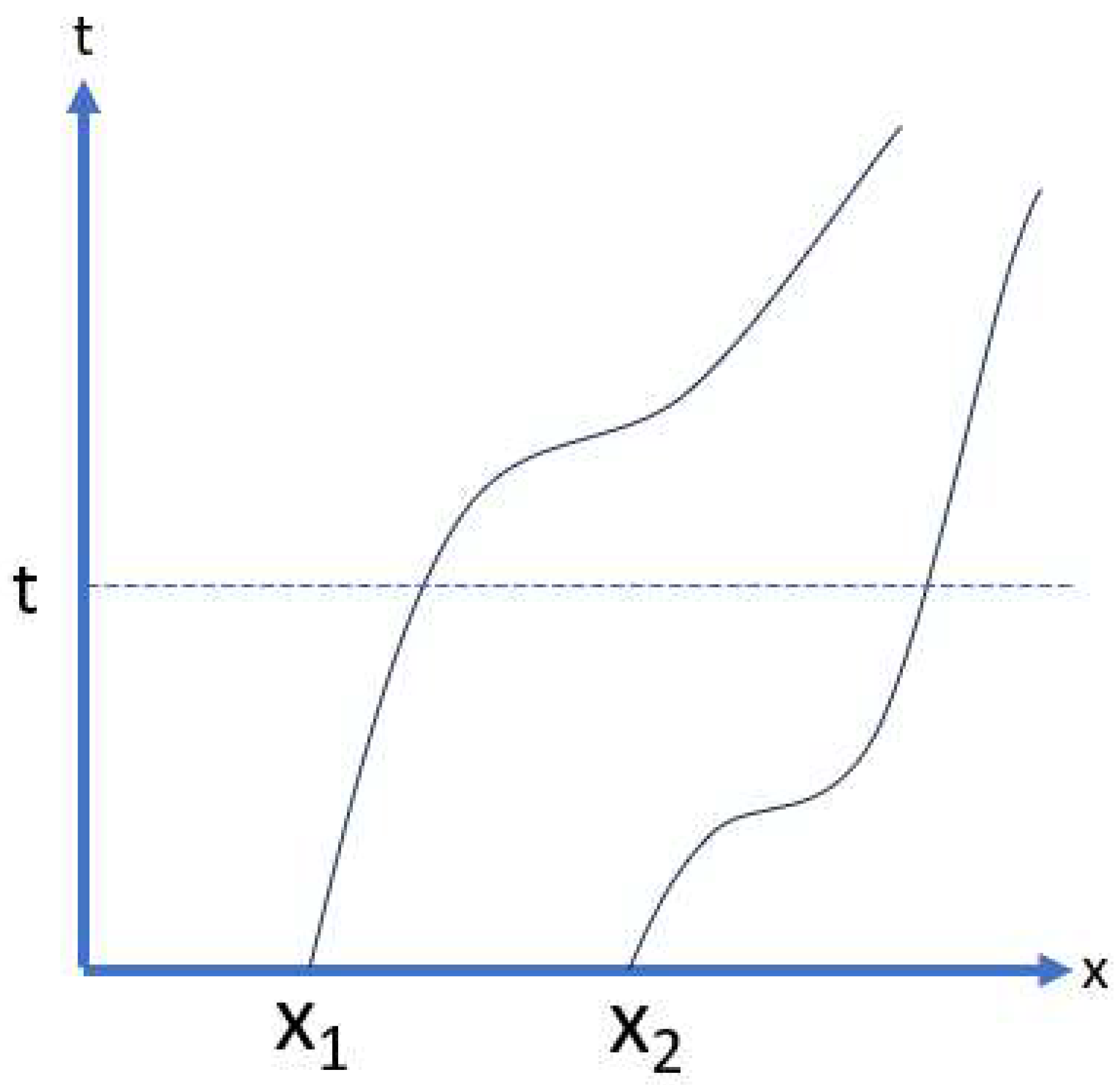A Fluid Perspective of Relativistic Quantum Mechanics
Abstract
:1. Introduction
2. Variational Analysis of Relativistic Trajectories
2.1. Space and Time
2.2. The Lagrangian
2.3. The Action and Lagrangian for a System of Particles
3. The Lagrangian Description of a Relativistic Charged Fluid
3.1. Action and Lagrangian
3.2. Variational Analysis
4. The Clebsch Approach to a Relativistic Charged Eulerian Fluid
4.1. Euler’s Equations
4.2. Simplified Action
5. Conclusions
Funding
Institutional Review Board Statement
Data Availability Statement
Conflicts of Interest
References
- Yahalom, A. Fisher Information Perspective of Pauli’s Electron. Entropy 2022, 24, 1721. [Google Scholar] [CrossRef] [PubMed]
- Yahalom, A. Fisher Information Perspective of Pauli’s Electron. In Proceedings of the 15th Chaotic Modeling and Simulation International Conference, CHAOS 2022, Florence, Italy, 9–12 June 2020; Skiadas, C.H., Dimotikalis, Y., Eds.; Springer Proceedings in Complexity. Springer: Cham, Switzerland, 2023. [Google Scholar]
- Weinberg, S. Gravitation and Cosmology: Principles and Applications of the General Theory of Relativity; John Wiley & Sons, Inc.: Hoboken, NJ, USA, 1972. [Google Scholar]
- Misner, C.W.; Thorne, K.S.; Wheeler, J.A. Gravitation; W.H. Freeman & Company: New York, NY, USA, 1973. [Google Scholar]
- Padmanabhan, T. Gravitation: Foundations and Frontiers; Cambridge University Press: Cambridge, UK, 2010. [Google Scholar]
- Goldstein, H.; Poole, C.P., Jr.; Safko, J.L. Classical Mechanics, 3rd ed.; Pearson: London, UK, 2001. [Google Scholar]
- Eckart, C. Variation Principles of Hydrodynamics. Phys. Fluids 1960, 3, 421–427. [Google Scholar] [CrossRef]
- Bretherton, F.P. A note on Hamilton’s principle for perfect fluids. J. Fluid Mech. 1970, 44, 19–31. [Google Scholar] [CrossRef]
- Gronwald, F.; Muench, U.; Macias, A.; Hehl, F.W. Volume elements of spacetime and a quartet of scalar fields. Phys. Rev. D 1998, 58, 084021. [Google Scholar] [CrossRef]
- Guendelman, E.I.; Kaganovich, A.B. Principle of nongravitating vacuum energy and some of its consequences. Phys. Rev. D 1996, 53, 7020. [Google Scholar] [CrossRef] [PubMed]
- Guendelman, E.I.; Kaganovich, A.B. Gravitational theory without the cosmological constant problem. Phys. Rev. D 1997, 55, 5970. [Google Scholar] [CrossRef]
- Guendelman, E.I.; Kaganovich, A.B. Gravitational theory without the cosmological constant problem, symmetries of space-filling branes, and higher dimensions. Phys. Rev. D 1997, 56, 3548. [Google Scholar] [CrossRef]
- Yahalom, A. The Fluid Dynamics of Spin. Mol. Phys. 2018, 116, 2698–2708. [Google Scholar] [CrossRef]
- Lamb, H. Hydrodynamics; Dover Publications: New York, NY, USA, 1945. [Google Scholar]
- Yahalom, A. The Fluid Dynamics of Spin—A Fisher Information Perspective. In Proceedings of the Seventeenth Israeli-Russian Bi-National Workshop 2018 “The Optimization of Composition, Structure and Properties of Metals, Oxides, Composites, Nano and Amorphous Materials”, Moscow, Russia, 13–17 August 2018. [Google Scholar]
- Yahalom, A. The Fluid Dynamics of Spin—A Fisher Information Perspective and Comoving Scalars. Chaotic Model. Simul. (CMSIM) 2020, 1, 17–30. [Google Scholar]

Disclaimer/Publisher’s Note: The statements, opinions and data contained in all publications are solely those of the individual author(s) and contributor(s) and not of MDPI and/or the editor(s). MDPI and/or the editor(s) disclaim responsibility for any injury to people or property resulting from any ideas, methods, instructions or products referred to in the content. |
© 2023 by the author. Licensee MDPI, Basel, Switzerland. This article is an open access article distributed under the terms and conditions of the Creative Commons Attribution (CC BY) license (https://creativecommons.org/licenses/by/4.0/).
Share and Cite
Yahalom, A. A Fluid Perspective of Relativistic Quantum Mechanics. Entropy 2023, 25, 1497. https://doi.org/10.3390/e25111497
Yahalom A. A Fluid Perspective of Relativistic Quantum Mechanics. Entropy. 2023; 25(11):1497. https://doi.org/10.3390/e25111497
Chicago/Turabian StyleYahalom, Asher. 2023. "A Fluid Perspective of Relativistic Quantum Mechanics" Entropy 25, no. 11: 1497. https://doi.org/10.3390/e25111497
APA StyleYahalom, A. (2023). A Fluid Perspective of Relativistic Quantum Mechanics. Entropy, 25(11), 1497. https://doi.org/10.3390/e25111497





